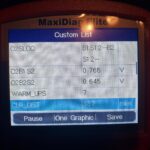Understanding your car’s OBD2 data can be invaluable in diagnosing and resolving potential issues. Knowing the normal OBD2 values allows you to identify anomalies that may indicate underlying problems. This guide will explore essential OBD2 parameters and their typical ranges, empowering you to interpret your car’s data effectively.
Key OBD2 Parameters and Their Normal Values
Several crucial parameters are available through an OBD2 scanner, each offering insights into different aspects of your vehicle’s performance. Let’s delve into some of the most important ones:
Fuel Trim
-
Short-Term Fuel Trim (STFT): Measures immediate adjustments the engine control module (ECM) makes to the fuel mixture. Normal values typically fall within ±5%. Fluctuations are common as the ECM constantly fine-tunes the fuel delivery. Values exceeding ±10% may indicate a problem.
-
Long-Term Fuel Trim (LTFT): Reflects long-term adjustments made by the ECM to compensate for consistent lean or rich conditions. Like STFT, normal values are usually within ±5%, with significant deviations suggesting a persistent issue. Consistently high positive values could point to a vacuum leak or low fuel pressure, while consistently low negative values could indicate faulty oxygen sensors or a rich fuel mixture.
 Fuel Trim Graph
Fuel Trim Graph
Checking fuel trim at different engine speeds (idle, 1500 RPM, 2500 RPM) helps pinpoint the problem. For instance, a lean condition only at idle might suggest a vacuum leak, while a consistent issue across all RPMs could indicate a fuel delivery problem.
Oxygen Sensor (O2)
- Oxygen Sensor Voltage: O2 sensors measure the oxygen content in the exhaust gases. A healthy sensor will fluctuate rapidly between 0.1 volts (lean) and 0.9 volts (rich). Slow transitions or readings stuck at either extreme indicate a faulty sensor.
Mass Air Flow (MAF) Sensor
- MAF Sensor Readings: Measured in grams per second (gm/s) or pounds per minute (lb/min), this parameter indicates the amount of air entering the engine. Compare your readings to the manufacturer’s specifications. Deviations can signify a dirty or failing MAF sensor, impacting fuel efficiency and performance.
Manifold Absolute Pressure (MAP) Sensor
- MAP Sensor Readings: This sensor measures the pressure inside the intake manifold. Readings vary depending on engine load and throttle position. Consult your vehicle’s service manual for the expected range. Unusual readings can indicate vacuum leaks, a faulty MAP sensor, or other intake issues.
Other Important Parameters:
- Engine Coolant Temperature (ECT): Should reach normal operating temperature (around 190°F or higher).
- Intake Air Temperature (IAT): Should be close to ambient temperature when the engine is cold.
- Engine Speed (RPM): Should be stable at idle and respond smoothly to throttle input.
- Vehicle Speed Sensor (VSS): Should accurately reflect the vehicle’s speed.
- Throttle Position Sensor (TPS): Should show a smooth increase and decrease in voltage as the throttle is opened and closed.
Enhanced OBD2 Parameters
Modern vehicles often provide access to additional parameters beyond the standard OBD2 set. These can include:
- Evaporative Emission (EVAP) System Data: Helps diagnose leaks in the EVAP system.
- Catalyst Temperature: Monitors the catalytic converter’s operating temperature.
- EGR System Data:Provides insights into the Exhaust Gas Recirculation (EGR) system’s functionality.
Using OBD2 Data for Diagnostics
Understanding Obd2 Normal Values empowers you to use your scan tool effectively for diagnostics. By comparing your readings to the expected ranges, you can identify potential issues and narrow down the possible causes. Always consult your vehicle’s service manual for specific information and troubleshooting guidance. Remember, while OBD2 data is a powerful diagnostic tool, it’s essential to consider other factors, such as symptoms and visual inspections, for a comprehensive diagnosis.
Conclusion
Familiarizing yourself with OBD2 normal values is crucial for anyone interested in understanding their car’s health and performance. By regularly monitoring these parameters, you can detect potential problems early on, potentially saving you time and money on repairs. Utilizing an OBD2 scanner in conjunction with this knowledge transforms you from a passive driver to an informed vehicle owner, equipped to tackle automotive challenges head-on.

